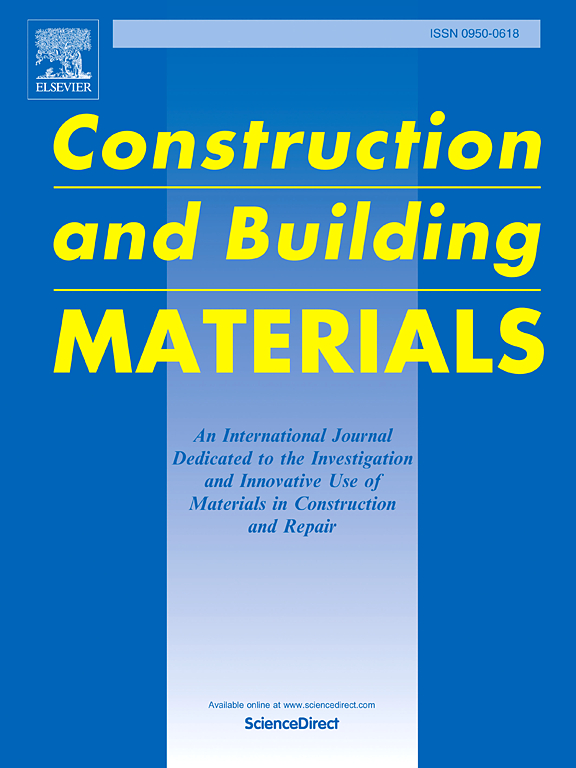砂中水玻璃增强生物胶结的效果:早期强度增强和机理见解
IF 7.4
1区 工程技术
Q1 CONSTRUCTION & BUILDING TECHNOLOGY
引用次数: 0
摘要
微生物诱导碳酸盐降水(MICP)被认为是加固地基的有效方法。为了提高生物胶结砂的早期强度,本文将水玻璃(Na2O-mSiO2-nH2O)作为添加剂加入到MICP中。通过一系列试管试验,定量研究了不同脲酶活性下水玻璃浓度对沉淀速率和沉淀量的影响。实验结果表明,通常情况下,Na2O的增加会阻碍MICP的形成,而SiO2的增加则会促进MICP的形成,这两种作用都受脲酶活性的控制。SiO2的最佳浓度为2 %、3 %和8 %,脲酶活性分别为25 KU/L、15 KU/L和10 KU/L。然后,进行砂柱试验,量化强度增强。与对照试验相比,单次处理后的无侧限抗压强度(UCS)提高了32.3% %,三次处理后的无侧限抗压强度(UCS)分别提高了26.5% %,割线模量(E50)在单次、两次和三次处理后分别提高了37.8% %、33.8% %和38.1 %。脲酶活性为10KU/L。同时,通过显微和成分分析,将反应过程分为三个不同的阶段。在第1阶段,析出游离Ca 2 +,水合硅酸钙(C-S-H)作为潜在成核位点。在第二阶段,C-S-H层内钙脱钙,为MICP提供持续的钙。在第三阶段,细菌被包裹,反应达到稳定。本研究提出了一种潜在的方法,为增强MICP的强化效应提供了参考。本文章由计算机程序翻译,如有差异,请以英文原文为准。
Effect of water glass-enhanced biocementation in sand: Early strength enhancement and mechanistic insights
Microbially induced carbonate precipitation (MICP) is considered an effective way to reinforce the ground. To improve the early strength of biocemented sand, in this paper, water glass (Na2O-mSiO2-nH2O) was incorporated into MICP as an additive. A series of tube tests were employed to quantitatively investigate the impact of water glass concentration on precipitation rate and amount under varying urease activities. Experimental observations revealed that, in general, MICP was hindered by an increase in Na2O while being promoted by SiO2, both effects were controlled by urease activity. For SiO2, optimal concentrations are 2 %, 3 %, and 8 % at urease activities of 25 KU/L, 15 KU/L, and 10 KU/L respectively. Then, the sand column experiments were conducted to quantify the strength enhancement. Compared with the control tests, the unconfined compression strength (UCS) was enhanced by 32.3 % after a single treatment and by 26.5 % after three treatments, respectively, while their secant modulus (E50) rose by 37.8 %, 33.8 %, and 38.1 % following single, two, and three treatments. at a urease activity of 10KU/L. Simultaneously, based on the microscopic and compositional analyses, three distinct stages were summarized during the reaction period. In stage 1, free Ca²⁺ was precipitated and calcium silicate hydrate (C-S-H) served as potential nucleation sites. In stage 2, the intralayer calcium of C-S-H was decalcified, providing sustained calcium for MICP. In stage 3, bacteria were coated and the reaction reached stabilization. This study proposed a potential method and provided reference insights for enhancing the reinforcement effect of MICP.
求助全文
通过发布文献求助,成功后即可免费获取论文全文。
去求助
来源期刊

Construction and Building Materials
工程技术-材料科学:综合
CiteScore
13.80
自引率
21.60%
发文量
3632
审稿时长
82 days
期刊介绍:
Construction and Building Materials offers an international platform for sharing innovative and original research and development in the realm of construction and building materials, along with their practical applications in new projects and repair practices. The journal publishes a diverse array of pioneering research and application papers, detailing laboratory investigations and, to a limited extent, numerical analyses or reports on full-scale projects. Multi-part papers are discouraged.
Additionally, Construction and Building Materials features comprehensive case studies and insightful review articles that contribute to new insights in the field. Our focus is on papers related to construction materials, excluding those on structural engineering, geotechnics, and unbound highway layers. Covered materials and technologies encompass cement, concrete reinforcement, bricks and mortars, additives, corrosion technology, ceramics, timber, steel, polymers, glass fibers, recycled materials, bamboo, rammed earth, non-conventional building materials, bituminous materials, and applications in railway materials.
 求助内容:
求助内容: 应助结果提醒方式:
应助结果提醒方式:


